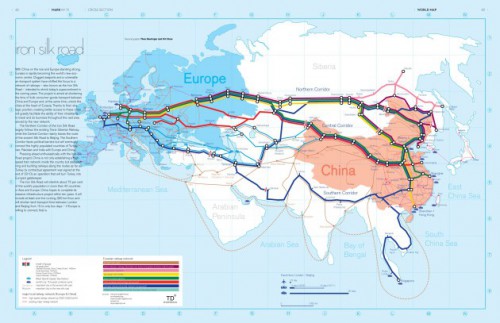vendredi, 05 septembre 2014
India and Japan must propel the Eurasian juggernaut

Railway highways in Eurasia
India and Japan must propel the Eurasian juggernaut
By Atul BHARDWAJ (India)
Ex: http://orientalreview.org
The breakup of Sino- Soviet ideological alliance was Kissinger’s unkindest cut of the Cold War. A strong socialist consolidation could have offered a vigorous challenge to transatlantic hegemony. Not only did Kissinger create schisms within the communist ranks, he also made sure that India and Japan, the Asian giants, disenchanted with the West, were kept away from the probable Eurasian formation. The death of Stalin and the Japanese and the Indian elite joining the American’s anti-communist war, made China feel isolated and vulnerable. In early 1970s, China formally abandoned the communist bloc to become partners with capitalist America.
Almost 25 years after the end of Cold War, the specter of a budding Sino-Russian alliance is once again giving America sleepless nights. America is palpably worried because the post cold war Russia-China alliance is not standing on ‘love and fresh air’ of ideology. This new Eurasian ties are being built on strong fundamentals – Chinese economic and financial might combined with Russian resolve and military power. It is built on the common belief, that “unipolarity is pernicious” and needs to be challenged.
The formation of the BRICS bank – China’s proposal of a new “economic Silk Road” linking Germany, Russia and China coupled with the Russian Defence Minister Sergei Shoigu’s announcement of the prospects of extending the Siberia railway line through Western Mongolia to Urumxi, China, and from there to Pakistan and India are not just bold but path breaking moves.
The year 2014 is fast turning out to be a year where the discourse is increasingly veering towards currency swap and connectivity corridors. Neither the Silk Road nor the currency swaps ideas are new. However, the current Chinese economic diplomacy overtures have gained greater salience due the fact that Russia, with hydrocarbon trade estimated at approximately a trillion dollars per year has abandoned the “petro-dollar” as the trading unit for oil and gas transactions. Coupled to this development is the fact that China, the second biggest economy in the world and a top importer of oil is inching closer to Russia and earnestly “seeking oil trading arrangements with its major suppliers, including Russia, Saudi Arabia, Iran and Venezuela, based on exchange of national currencies.” It is reported that by 2018 Russia would be pumping into China 38 billion cubic meters of natural gas per year with “transactions to be valued in the Russian ruble, Chinese yuan or possibly in gold.”
These developments have already caused jitters in the U.S. stock markets and rising levels of global skepticism related to the future of dollar as a reserve currency. Tensions are also building up in the Black Sea where it was recently reported that the American warship are unnecessarily loitering around with a hope to threaten President Putin. Russia is well versed with this futility inherent in the American gunboat diplomacy. Such maneuvers on the high seas were common during the Cold War, when the Soviet and the US warships, bound by the rules of engagement, used to engage in a peaceful duel, with both just engaging in harassing each other by showing off ship handling skills or by training the missiles from left to right.
The question is will the churning in the global political economy lead to increased muscle flexing and gunboat diplomacy by the US or will the dwindling dollar usher in a new era of genuine multi-polarity in the international order. However, before we move further, it must be clarified that the decline of the US in the 21st century is not absolute. It is merely relative to the remarkable growth of China. What is happening today is not the liquidation of the US Empire but the shaking of its foundation? The rise of China from a state of poverty and Russia from a state of strategic dormancy does open up the international order, offering more choices to emerging economies like India.
This time India should not fall into the American trap and betray the BRICS and thus the emerging Eurasian formulation. This is probably the world’s best chance to tame Western hegemony. India along with Japan should not fretter away this opportunity merely because of a tiny Senkaku island and Shinzo Abe’s fetish to turn Tokyo into a military garrison.
It is high time that the proposal of a new “maritime silk road” is not seen as Chinese stratagem, a devious scheme to deceive the region and establish hegemony, but a broader strategy to enhance connectivity across Asia, offering a fresh model to catapult the region out of the territorial trap. The Russo-Chinese baby steps to move out of the U.S. underwritten system of dollar dominance, and perpetual insecurity to chart a new world order.
The writer is a senior fellow of the Indian Council of Social Science Research, Institute of Chinese Studies. He is an alumnus of King’s College, London.
00:05 Publié dans Actualité, Eurasisme, Géopolitique | Lien permanent | Commentaires (0) | Tags : politique internationale, japon, inde, asie, affaires asiatiques, eurasie, eurasisme, géopolitique |  |
|  del.icio.us |
del.icio.us |  |
|  Digg |
Digg | ![]() Facebook
Facebook



Les commentaires sont fermés.